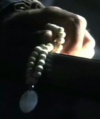Religion in the Twelve Colonies (RDM)
More actions
- This article discusses the religion of the Colonies as seen in the Re-imagined Series. For summary information on the Kobollian religion from the Original Series, see Religion in the Twelve Colonies (TOS).
- For information on the various mythologies used in Battlestar Galactica, see Mythological references.
| Part of the series on | ||||||||||||
|
| ||||||||||||
The dominant religion of the Twelve Colonies, which the various characters of Battlestar Galactica practice to greater or lesser extent, is a polytheistic faith[1] with a strong emphasis on the philosophy of eternal return. There is a several variations of this faith practiced by different groups.
A small, monotheistic minority of the Colonials secretly worshipped a single god. [2] Gaius Baltar later founds a monotheistic cult which finds itself in conflict with the established faith.
Origin
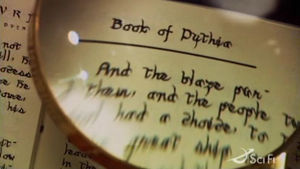
The eternal return aspect between the peoples of Kobol and Earth suggest a parallel or reverse-origin with humanity as a whole or the Thirteenth Tribe that presumably populated it. See History of the Twelve Colonies for more analysis.
In the burial scene of the Miniseries, William Adama states, "Life here began out there,[3]" reminding the assembly that this was the first line of the Sacred Scrolls, the principle religious tome of the Colonial faith, told to them by the Lords Of Kobol many centuries ago.
Belief
The Lords of Kobol
Colonial religion is centered on the Lords of Kobol. In the Re-imagined Series, ten Lords of Kobol have been positively identified:
- Zeus - The leader of the gods. Tom Zarek has twice referred to Commander Adama as "Zeus" ("Bastille Day", "The Farm", as a play on Capt. Apollo's callsign).
- Aphrodite - The goddess of love and sexuality. Kara Thrace prays often to this lord (Flesh and Bone).
- Apollo - Zeus' son, said to be the god of the hunt and of healing (Bastille Day).
- Ares - The god of war. The infant son of Cally and Galen Tyrol is dedicated to this Lord of Kobol (The Resistance, Episode 10).
- Artemis - Twin sister of Apollo, goddess of the hunt. Kara Thrace prays often to this lord (Flesh and Bone).
- Asclepius - The god of healing (Escape Velocity).
- Athena - This lord committed suicide "out of despair over the exodus of the thirteen tribes" (Home, Part II). Her tomb holds a map to Earth (Kobol's Last Gleaming, Part I).
- Aurora, Goddess of the Dawn (Maelstrom)[4].
- Hera - Wife of Zeus. A mountain ridge on Kobol is named after her (Home, Part II), and the first Cylon/human hybrid child is named for this lord (Downloaded).
- Poseidon - Gaius Baltar mentions this deity in a conversation with Tracey Anne (He That Believeth In Me).
The Colonials appear to use multiple names for their gods, interchanging "Mars" for "Ares," "Jupiter" for "Zeus," and so on.[5]
Paradise Lost
According to the Sacred Scrolls, the gods once shared a paradise-like existence with the people of Kobol. Later circumstances forced the exodus of the human population of Kobol to the Twelve Colonies and Earth, and lead to Athena's suicide.
The existence of the Lords of Kobol is attested to by the survival of numerous artifacts, including the Arrow of Apollo, the Tomb of Athena and the Gates of Hera. However, although she accepts their historic authenticity, Caprica-Valerii, a Cylon, questions their actual divinity.[6]
The Jealous God
Elosha states that the exodus from Kobol was precipitated when "one jealous god began to desire that he be elevated above all the other gods, and the war on Kobol began."[7]
The Path of Olympus
Tom Zarek conveys to Laura Roslin and her followers the news that Commander William Adama had resumed command of Galactica after the attempt on his life by saying: "Zeus has returned to Olympus" (The Farm).[8] By Zarek's comment we can infer that Colonial religion appears to acknowledge the existence of a place called Olympus. It cannot yet be determined, however, if Olympus was thought of as the residence of the gods at a specific physical or metaphysical location of Kobol, as there has been no mention of Olympus elsewhere in the series. If Olympus is a metaphysical locale, this may contradict Elosha's comment that the gods and man lived on Kobol together in harmony.
Other Mythological Names in Colonial Culture
Various items have been identified which are apparently named after other gods and legendary figures of their faith, although these have not been explicitly identified as Lords of Kobol.
- See main article: Mythological references
The Cycle of Time
"All this has happened before, and all this will happen again."
According to Gaius Baltar, this line from the Pythian prophecy is very well known (The Hand of God). Laura Roslin later expands on it, reminding Kara Thrace,
"If you believe in the gods, then you believe in the cycle of time that we are all playing our parts in a story that is told again, and again, and again throughout eternity" (Kobol's Last Gleaming, Part I).
Various events throughout the series have led some characters to believe that they are playing out another turn of this cycle[9]. (See Sacred Scrolls for more detailed analysis.)
Sanctity of Life
According to the Sacred Scrolls, abortion is "an abomination in the eyes of the Gods". The more fundamentalist Gemenese strictly adhere to this commandment, however the more secular Colonies such as Caprica apparently do not follow this as strictly: officially, Colonies-wide Federal law guaranteed a woman the right to an abortion, at least at the time of the Fall of the Twelve Colonies (The Captain's Hand).
Individual Practice
The Colonials display a wide spectrum of religious practice, ranging from Billy Keikeya's atheism (Home, Part II, cut scene) to Corporal Venner's literalistic readings of the Sacred Scrolls.
While not fully explained in the Re-imagined Series, it appears, based on the information from a dedication ceremony for Nicholas Tyrol and the prayers of Kara Thrace, that each Colonial is paired, or "placed in the service" with one or more of the Lords. Based on the dedication ceremony blessing, Zeus is a considered "almighty" or foremost of the gods, while other Lords are prayed to by Colonials as a proxy to Zeus.[10]
Artifacts
Despite Gemenon's fundamentalist climate, the city of Delphi on Caprica was apparently of a mind to store an important religious artifact, the Arrow of Apollo, in a museum, rather than a devotional institution (Kobol's Last Gleaming, Part II).
Ancient temples may be also be the repository of special artifacts such as the Eye of Jupiter, believed to be stored inside the legendary Temple of Five ("Rapture", "The Eye of Jupiter").
Dress
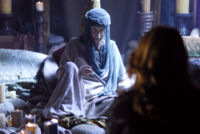
As seen by the various separatists orbiting Kobol in "Home, Part I", it appears that many Colonials have clothing that suggests a religious deference. In the scene, one older, white-bearded gentleman is dressed in simple colored robes and a round, flat head covering[11] Other distinctive dress styles of other characters in the scene increase the sense of the dedication of religion in the Gemenese people (which appear to comprise the majority of Roslin's separatists).
The oracle Dodona Selloi dresses in a turban and robes, suggesting a special role in Colonial society or its religious hierarchy (Exodus, Part I).
Idols
At the end of the episode "Flesh and Bone", Kara Thrace, a devotee of Artemis and Aphrodite (as stated by Leoben Conoy in the same episode), prays to them on Conoy's behalf using figurines that bear a similarity to classic representations of Artemis and Athena. Artemis is depicted with her bow and arrow, and Athena with her helmet of war.
When visting the oracle Yolanda Brenn, Thrace receives a figurine of the goddess Aurora as a gift (Maelstrom).
Prayer
Some prisoners on the Astral Queen seeking rehabilitation have turned to group prayer. They greet Laura Roslin as a prophet and she provides them with a blessing (The Farm).
Priest Elosha sings a group prayer in a Service for the dead after the Fleet escapes from the initial Cylon attack (Miniseries).[12] The priest also gives a prayer after Colonial One is boarded by Commander Adama's troops to remove Roslin from power (Kobol's Last Gleaming, Part II).
A chaplain delivered a simple prayer at the funeral of Zak Adama, two years prior to the fall of the Colonies (Act of Contrition)[13]:
"The burdens of this life are with us but a short time. For Lieutenant Zak Adama, son of William and Carolanne Adama, brother of Lee, the time was too short, but we take comfort in knowing his life was willingly given in service to all of us. We honor them for that. And thus, it falls upon us to repent our sins and with the help of the Lords of Kobol, make our own lives worthy of that gift. And now, we commit his body to the ground from which we were all made."
Corporal Venner asks Laura Roslin to join him in a simple prayer while Galactica is attacked as it desperately tries to find its Fleet (Scattered).
(To Roslin:) Will you pray with me? (He begins:) Help us, Lords of Kobol. Help your prophet Laura guide us to the path of righteousness. That we might-- that we might destroy our enemies. Let us walk the path of righteousness and lift our faces unto your goodness. Help us turn away from the calls of the wicked and show us the knowledge of your certain salvation. We offer this prayer.
Prayer is also seen in the Season 3 webisode series in a temple (where prayers are written and then burned before an idol), and by Kara Thrace (Miniseries, "Flesh and Bone").
Rosaries
As Laura Roslin begins to suffer from chamalla withdrawal in Galactica's brig, Corporal Venner, a Gemenese, anxiously clutches a set of white prayer beads (Fragged).
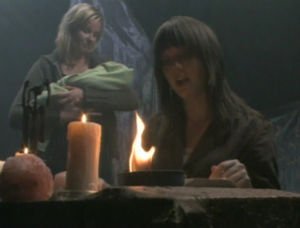
Temples may have been more elaborate places on the Twelve Colonies, but the spaceborne remnants of humanity presumably use any space they can find on their ships to form a basic temple. As seen on New Caprica, a basic temple may consist of a simple altar with candles, idols of the Lords of Kobol, and what meager offerings the Colonials can give as a tithe. Some prayers are written and paper and burned (Battlestar Galactica: The Resistance).
The temple on New Caprica was known as the Temple of Artemis (Collaborators), suggesting that temples are dedicated to a Lord or Lords, and may be related to the pairing of Colonials to a specific set of Lords at their dedication ceremony.
A similar arrangement to temple is found in an oracle camp (Maelstrom).
A room used for religious services on Galactica is referred to as a temple (Escape Velocity).
Sagittaron beliefs
Orthodox Sagittaron beliefs are more anachronistic than the Gemenese's, believing that the mind and body are myths, and that medicine is "an abomination, a sin against the Gods". Sagittarons also blame physicians for the spread of disease due to their ignorance of the aforementioned "myth" of the body and mind. They traditionally do not believe in violence, even to the point of not aiding the New Caprica Resistance in their fight against the Cylon occupation of New Caprica (The Woman King).
Other minority beliefs
The Sons of Ares and Mithraism are mentioned in "Escape Velocity".
The Clergy
The religious and government bodies of the Twelve Colonies work together. This association is likely based on the religious homogeneity of the Colonies.[14]
Priests
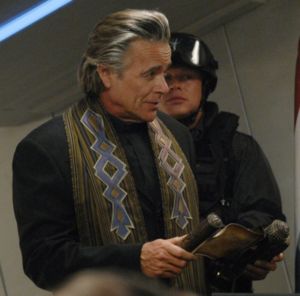
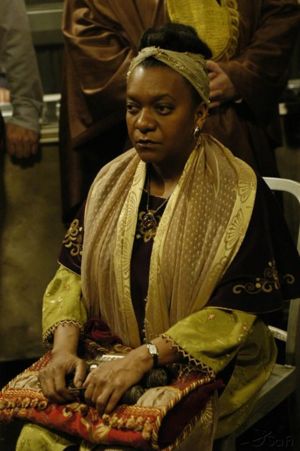
Laura Roslin is sworn into the presidency by a priest, Elosha, who continues on in an advisory capacity within Roslin's administration. Priests also preside over military funerals, without regard for the beliefs of the deceased.
Priests in the Twelve Colonies are apparently not required to practice celibacy, and can be male or female. Chief Galen Tyrol states that his father was a priest and his mother an oracle (Resistance).[15]
According to Billy Keikeya, some priests use chamalla for its hallucinogenic properties. The prescient dreams it imparted to Laura Roslin may imply the use of something similar by Pythia, an ancient prophet. Oracles also use the drug.
Brothers
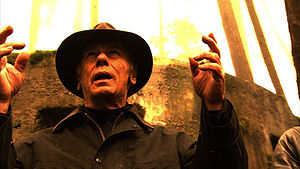
The term Brother is used as a title for male members of the clergy, although it is not fully apparent whether this role is similar to that of a monk or deacon.
As with priests, a brother offers consultation and leads prayer.
The only instance of this clergy is Brother Cavil, who offers guidance to Chief Tyrol.
Cavil, however, is revealed as a humanoid Cylon some time later. Because of Cavil's nature, there may be doubt as to whether Cavil is a useful example of the work of a Brother in Colonial religion.
It is probable that Brothers are lay clergy (unlike priests and oracles, who appear to have political status as well as their religious status).
Sisters

As with Brothers in the clergy, there are Sisters as well.
Sister Tivenan is briefly seen tending to business in the temple on New Caprica, guiding prayer and officiating a dedication ceremony for the newborn son of Galen and Cally Tyrol (Battlestar Galactica: The Resistance).
It is probable that Sisters, like Brothers, are lay clergy.
Oracles
- Main article: Oracle
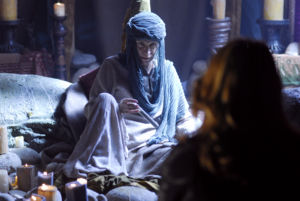

There is little information as to the religious functions of oracles. Dodona Selloi is one of two oracles seen in the Re-imagined Series. She confirms the dreams of a copy of Number Three and the existence of Hera. It is not clear if Selloi is sitting in a tent designated as a temple, but there are numerous ornate or curious inscriptions surrounding and inside her tent that suggest the significance of the oracle's tent or her presence. A second oracle, Yolanda Brenn, gives counsel to Kara Thrace on her strange dreams aboard Galactica (Maelstrom).
Priests and oracles may assume their roles due to an personal, possibly inherited affinity to sense spiritual changes or conditions. Galen Tyrol, believed to be the son of a priest and oracle, detects the presence of and finds the Temple of Five alone, based only on his senses, apparently detecting the hidden temple on the otherwise-unremarkable (and undocumented) algae planet (The Eye of Jupiter).
A Cylon Connection
- Main article: Cylon Religion
- See Also: The Destiny, Final Five, Temple of Five
While humanoid Cylons show a strict, firm belief in a monotheistic God, referring to the Lords of Kobol as "false idols," a connection between the Cylon God and the Lords of Kobol may exist. In "Exodus, Part I", an oracle tells Number Three (who has a dream of the oracle's tent and of holding the believed-dead hybrid child Hera) that she has a message from the one that Number Three worships. This poses the question how an oracle of the Lords of Kobol be able to hear the messages of the Cylon God.
A Kobollian god(s) was separated from the others (per a deleted scene about a jealous god).
The Temple of Five, which a Number Three uses to visualize the identities of the Final Five) was not built for the Cylons (who were not created until 4,000 years later) but for humans. The Temple, according to the Sacred Scrolls, was built for five priests who worshiped "The One Whose Name Cannot Be Spoken". It is not clear if this was the spurned "jealous god" or another fallen member of the Lords of Kobol. No further information on the connection between the Cylon and Colonial religions in regards to the Temple of Five is revealed as of the end of Season 3.[16]
Kara Thrace realizes her destiny, first from the words of a Leoben Conoy model, and later, in a type of dream, through a entity that took the likeness of Leoben, but was not a Cylon. From death, Thrace returns to the Fleet, not as an illusion, but resurrected -- something that, prior to Thrace, only a Humanoid Cylon could do.
References
- ↑ The Colonial deities are very similar to the Olympic gods of Greek mythology on the real-world Earth.
- ↑ http://www.tvsquad.com/2008/04/03/exclusive-caprica-casting-info-revealed/ Note: This information is based on early reports and casting sheets, and thus subject to change.
- ↑ This phrase is a homage to the Original Series, where each episode began with this phrase in a voice-over introduction.
- ↑ Aurora is the Roman counterpart of the Greek Eos. Eos is one of the Titans. Since the Lords of Kobol are modeled after the Twelve Olympians however, this could indicate that she is not one of the Lords, but belongs to another group of deities.
- ↑ Curiously, Laura Roslin mentions that the 134th day of the Cylon occupation of New Caprica is Mars Day (Occupation), suggesting that Ares may also be called by his alternate Roman pantheon's name. The same happens again in "The Passage" when Zeus is referred to by the name of his Roman counterpart Jupiter.
- ↑ There is a notion in fan circles that there are twelve lords of Kobol, by analogy to the twelve Cylon models, twelve Colonies, and perhaps the Twelve Olympians of Greek mythology. A post from Ron D. Moore's blog on March 12, 2005 loosely alludes on this coincidence, but further official sourcing has not been revealed.
- ↑ From a deleted scene cut from the episode "Kobol's Last Gleaming, Part I".
- ↑ In Greek mythology, the home of the gods on Earth resided high atop Greece's highest mountain, Mount Olympus, at a time where access to the mountain summit would be almost impossible with the inhabitants' technology of that age.
- ↑ The notion of a circular progression of time (also known as eternal return or eternal recurrence) is a common theme in other faiths, particularly Mayan mythology and is a cornerstone of the Hindu and Buddhist faiths. Moreover, Stoic philosophy did believe in the concept of ekpyrosis, the fire which consumes the old world and signals the birth of a new world, identical to the old, for a recurring cycle of birth, death and rebirth.
- ↑ This practice is similar to a Catholic practice of prayer to Mary, mother of Jesus. While Mary is a human, followers believe that, by praying to Mary, she can intercede to aid the acceptance of the prayer by the Trinity, the godhead of the Catholic faith.
- ↑ These robes may remind viewers of the tradition dress of Hasidic Jews, Islamic clerics, or Eastern Orthodox clerics of the real-world Earth.
- ↑ The language she sings is Sanskrit, a classical language of real-world Earth's Hindu/Indian peoples. More about the verses that she sings and their meaning can be found in the Language in the Twelve Colonies article.
- ↑ The prayer's mention of committing a "body to the ground from which we were all made" echoes the Biblical passage of Genesis 3:19:
- "By the sweat of your brow
- you will eat your food
- until you return to the ground,
- since from it you were taken;
- for dust you are
- and to dust you will return."
- ↑ This differs from the United States, whose government is based on religious tolerance through the separation of religious practice and legislature. While the real-world Earth has many, many religions, the Twelve Colonies, as yet, appear to have only one religion and as such does not suffer greatly from schisms or other religious factions, although colonists such as the Gemenese show a different emphasis on how they interpret the religious writings.
- ↑ Galen Tyrol's information may be skewed by the revelation that he himself is a Cylon (Crossroads, Part II).
- ↑ While the notion of a fallen Lord is speculative in the Re-imagined Series, there is already a parallel series of characters from the Original Series: The Beings of Light and their fallen member, Iblis. Ron D. Moore, however, has stated in several interviews that he was not planning to use this Original Series concept in the Re-imagined Series.




